
Today marks the third edition of Wildlife Wednesday for 2015. Tina and her blog My Gardener Says… hosts this meme as a way to celebrate the wildlife residing in our gardens.
I have to say that this was a strange month for my garden! The weather was very unpredictable, ranging from sunny and 80° to snowy and 20°. On several days I ran across some insect life I didn’t expect and actually saw some butterflies. Unfortunately they couldn’t find a place to settle so I didn’t get any shots of them. As usual, there were a lot of birds in the garden. Among my favorite avian visitors during the past month were the three featured in the photo above — American Goldfinch (Spinus tristis), Pine Siskin (Spinus pinus) and House Finch (Haemorhous mexicanus). It was an amazing sight to see these little birds sharing a thistle feeder. The Pine Siskin was a little pushy and aggressive at times, trying to chase the others away, but they all seemed to get along eventually! I do wonder what the Goldfinch and House Finch were looking at. They seem rather perturbed!
Below are two American Goldfinches (Spinus tristis) in the branches of a Bradford Pear (Pyrus calleryana ‘Bradford’) that was just beginning to bud. Unfortunately this tree and others of its kind in the yard will have to start all over due to the frigid weather. They’ll probably still bloom this year though not as profusely as usual.
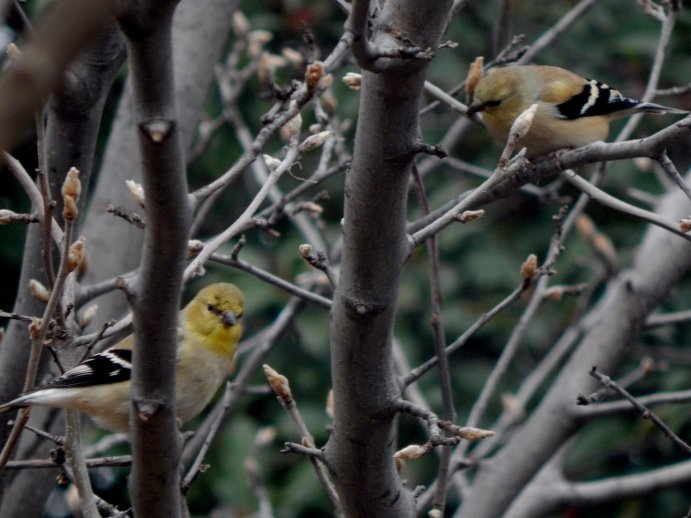
Here’s a photo of a pair of House Finches (Haemorhous mexicanus). The female is somewhat hidden among the twigs due to her dull color, but the male stands out quite nicely. They both look cold!
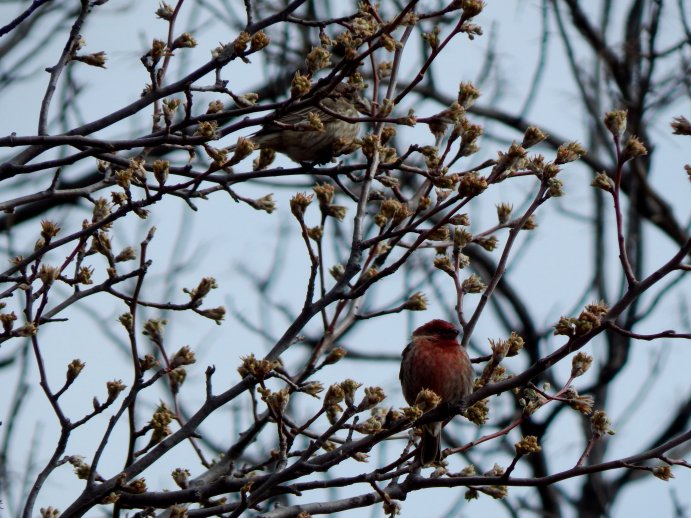
These two White-Crowned Sparrows (Zonotrichia leucophrys) put in an appearance this past weekend. I don’t know if they’ve been around and I just haven’t noticed them or whether this was their first visit. Either way, they’re an interesting sight to behold! Notice the stripes on their heads. The bird sporting the black and white stripes is an adult while the one with brown and gray stripes is an immature bird. These are winter visitors to this area and will probably be here until April.

We’ve had occasional visits by Cedar Waxwings (Bombycilla cedrorum) this winter. There seemed to be more of an abundance of them during the past month. I could never find any when I was actually looking for them. They appear to decide among themselves upon the time and place to make an appearance.
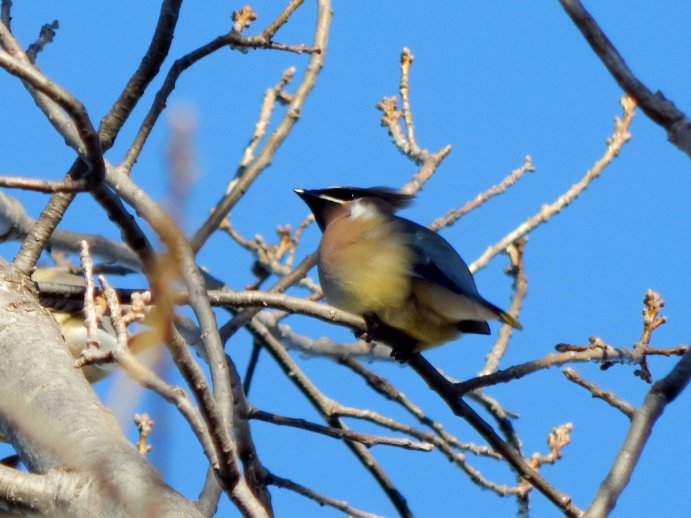
The two Eastern Fox Squirrels (Sciurus niger) below were romping around the back yard one day a week or so ago. Both came to a standstill and didn’t move a muscle for several minutes. It was then that I noticed the predator in the third photo. He’s resting on top of an old Purple Martin house that the squirrels have slowly converted to their own purposes. All that is really apparent is a mostly-white breast and white legs along with a spattering of brown. It appears to be a somewhat large bird based on the size of the bird house so may possibly be a Red-Tailed Hawk. I eventually went outside and shooed it away.
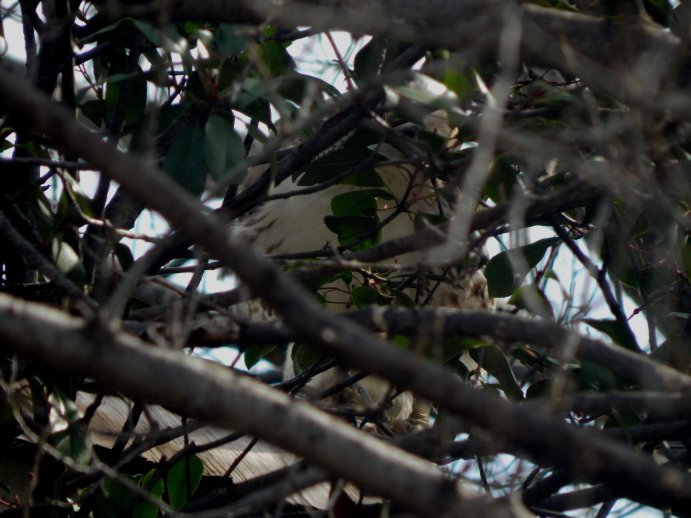
Here’s a photo of a Red-Winged Blackbird (Agelaius phoeniceus) gobbling up seed from a hanging feeder. The picture is a little grainy due to the shade of the shrubs and overcast sky, but I was particularly taken by his red and yellow shoulder patches.

Along with the brightly colored male Red-Winged Blackbirds we’ve also entertained (or been entertained by!) female and juvenile birds, as seen below.
Blue Jays (Cyanocitta cristata) are a back yard staple. I wonder if the two in this photo are a pair? It’s almost impossible to tell the gender of these birds because males and females are essentially the same size and have the same coloring. According to the Cornell Lab of Ornithology, “the oldest known wild, banded Blue Jay lived to be at least 17 years 6 months old.”
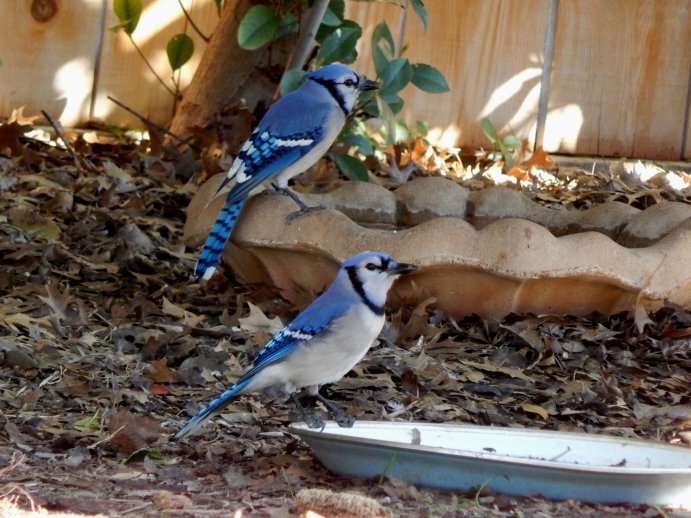
Here are a few more birds that visited during the past month:
I found these insect eggs while cleaning a flower bed. I suppose they can be considered wildlife since they’ll hatch into some type of bug one of these days!
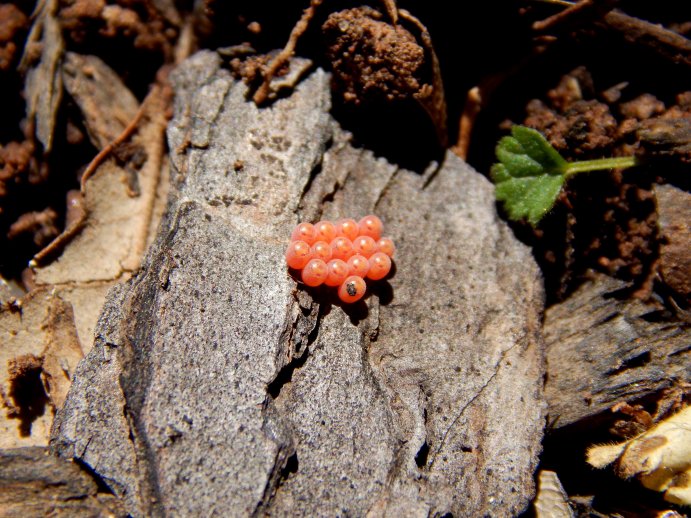
And how about this small green worm or caterpillar? I see these frequently but I’m not sure what they are.
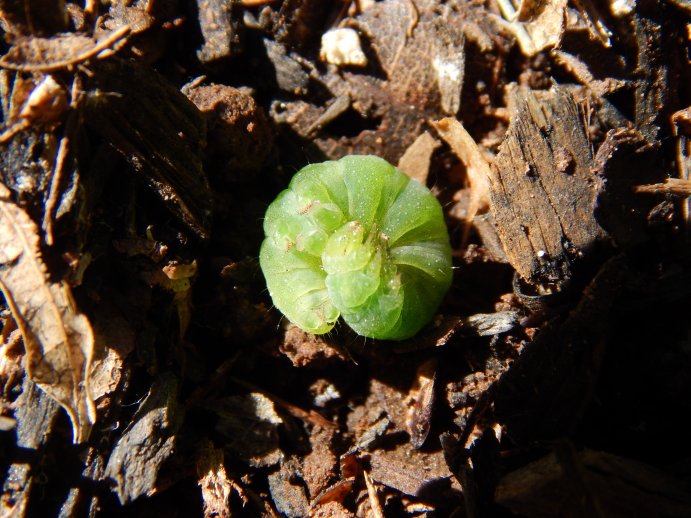
And last but not least, here is the track of a visitor we had one night — an Opossum (Didelphis virginiana). I’ve seen their tracks on other occasions and even had a live encounter with one in our back yard — during the day! — while doing yard work last summer. Following that encounter I did some research on opossums. I learned that they may come out during the day if they’re taking care of young and need to forage for food. Did you know that the Opossum is North America’s only marsupial?
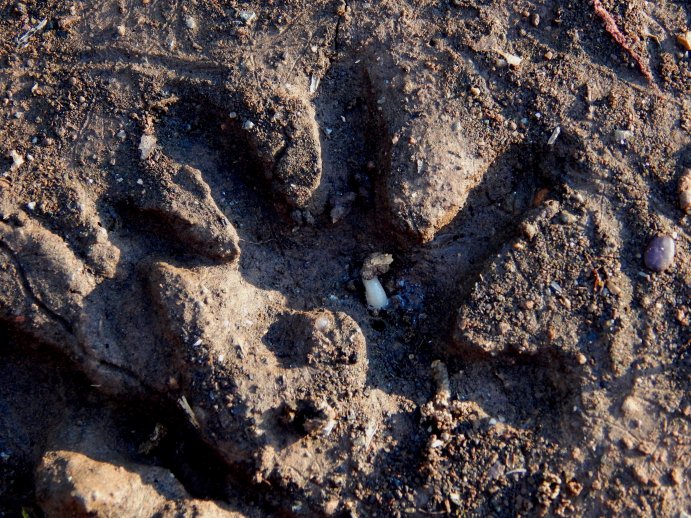
That’s my Wildlife Wednesday post for this month. By the time next month’s post rolls around it will be spring! Who knows what types of wild creatures might visit my garden before then?
Please visit My Gardener Says… to check out all the other Wildlife Wednesday posts. Or maybe you’d like to join in the fun and add a link to your own post! Have some fun — join Wildlife Wednesday!








That is fascinating about opossums – I had no idea! Despite the cold you are certainly getting a great variety of visitors (and wonderful photos of them to boot!). I’m a little envious – we are not seeing many different visitors yet but I’m holding out high hopes for the warmer weather to come.
LikeLike
I probably feed the birds too much, so they’re around all the time! But we do have an open field-like area (though small) behind our fence, so there’s an assortment of places to feed, especially at this time of year. So the birds tend to hang around more. I want the warm weather too, but will be sad that a number of these birds will be heading back to their summer homes when that happens.
LikeLike
I love your post, the photos are wonderful, and so many birds! The Blue Jays are stunning and the White Crowned Sparrows so pretty. You are quite right this is fun to spot wildlife in our gardens, I’d love to know who laid the eggs, I do not recognise them but its inspiring to think about the possibilities! Looking forward already to what you see during this month. 🙂
LikeLike
Thanks Julie. I’d like to know what kind of creatures will come from those eggs, too. Maybe I should have put them in a jar and watched them hatch. 🙂 They’ll probably turn out to be stink bug eggs! Those White-Crowned Sparrows are pretty. The white and black on their heads shows such contrast. They’re very hard to miss once you discover them. Aren’t birds wonderful? What would we do without them?
LikeLiked by 1 person
Fabulous post!! I loved all of your photos–every one. I think we have pine siskins here, but I’ve never seen them, or at least I don’t think I have. I wonder, looking at that great photo of the three different species if I’ve mistaken siskins for female house finches–they are similar in build, though slightly different in coloring.
I also really like those White Crowned Sparrows-wow, they’re beautiful! The Blue Jay photo really captures their coloring and the Cardinal with the seed in his beak–such a great shot!!
Thanks for participating in Wildlife Wednesday and sharing your garden visitor bounty!
LikeLike
I never noticed the Pine Siskins until I started putting out the thistle feeders. Then one day, there they were! They do resemble the female House Finch now that you mention it, due to the spreckled breast. But they have a sliver of yellow on the wing and have a sharp beak. I wish the one in that photo had turned his head also so it could have been in the shot. It’s amazing what you can attract to your yard if you just put out the right kind of food! I was shopping for some seed yesterday — I ran out and winter came again today — and another lady was doing the same. We started talking as we were grabbing supplies, comparing our bird visitors. It was quite fun and amusing. I also like the White-Crowned Sparrows. Again, they were just mingling with the usual assortment of sparrows we always have, but the white stripes caught my attention. Thanks for the kind words about the photos, I really enjoy taking them. Sometimes I think I spend far too much time at it! See you again next month!
LikeLike
A visual treat: thanks so much! BlueJays can be tough to photograph (for me at any rate) but a person wouldn’t know that looking at yours. Seeing an opossum print is a special treat. They are amazing creatures with a bad image problem. Really unappreciated. They nest here most years and I just adore them.
LikeLike
Believe me, most of my photos are just pure luck! I think I was probably aiming at something else and the Blue Jays settled in for a drink, so I snapped a quick picture. You’re right about the opossums. They’re really quite interesting, unique and ancient. Glad you enjoyed!
LikeLiked by 1 person
You have such a variety of wildlife to feature for a slow month. I loved seeing all your bird photos. Those squirrels are pesky but fun to watch.
LikeLike
Thank you! I’m one of those people that loves squirrels, I guess. We normally have a couple year round and they raise a brood or two each year. When they’re small they’re so cute.
LikeLike
Great photos! It’s great to see so much wildlife around despite the chill you guys are experiencing!
LikeLike
Thanks. The cold doesn’t seem to deter them!
LikeLiked by 1 person
Wow – so much wildlife this month! I understand the birds, considering they tend to not stray to far from the feeders at this time of year, but so many other types, too – definitely a menagerie of critters! Your white-crowned sparrows and male red-winged blackbirds are my favorite, probably because I haven’t seen any in my yard. Waxwings probably are truly my favorite, and I’ve always loved the beauty of the blue jays – so regal (unfortunately a bit of a bully). I’m so curious what are in those little jewel-like insect eggs!
LikeLike
I think the white-crowned sparrows were my favorite this month. They were something a little different. The blue jays can be bullies, can’t they? But they’re so pretty and smooth-looking that I can’t resist them.
LikeLike
I love the birds that visit your garden, like ours but it looks like some one has coloured them in in beautiful colours..The Blue Jays are stunning..
Amanda xx
LikeLike
Thanks so much. I love birds and it’s always so much fun to discover new ones. We have a small yard and garden area, but it just teems with wildlife sometimes, and I’m doing what I can to entice more critters to stop by!
LikeLike
Look at all the wonders of your garden. Many of my birds are hitting neighbors feeders as the seed heads are scarce this winter….I haven’t seen but a goldfinch or two all winter…hopefully with some warmer weather coming next our snow will melt.
I also am writing about the waxwings today as they are a favorite bird I long to see…wonderful they visit you too now on their way north.
LikeLike
The waxwings are so interesting and other-worldly! This is the first year I’ve noticed them. I’m sure they’ve been here before but I just wasn’t looking. Sometimes we just take so much for granted…
LikeLike
A most enjoyable, and informative, post with wonderful photos. You really do see such a varid selection of birds. xx
LikeLike
Thanks, glad you enjoyed this month’s WW post. Birds are so much fun to watch!
LikeLike